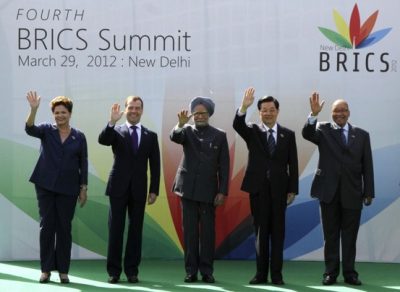Nonetheless, the Delhi summit’s outcomes, as reflected in the Delhi Declaration, should not be underestimated. By initiating a BRICS-led South–South bank and taking up the agenda for intra-BRICS trade in the currencies of the member countries to move away from US dollar-denominated global commerce, the summit has started a process with major global implications in the coming years.
There was significant progress on the economic and commercial fronts if we take note of South African Trade and Industry Minister Rob Davies’ announcement that at the next BRICS conference, the host, his government, will consider setting up a permanent mechanism to facilitate cross-border investment flows in BRICS.
The importance of these announcements can be fully appreciated in the context of the substantial and rapidly increasing economic clout of BRICS in the global economy. The five countries account for 43 per cent of the world population — a share likely to increase in the coming years; 23 per cent of the global economic activity; and an equally large share of global commerce.
At $240 billion, intra-BRICS trade is a small fraction of their trade and way below the potential, but it has been growing at 28 per cent annually and is expected to expand even more rapidly in the coming years as the five take steps to improve bilateral and multilateral efforts to facilitate trade and investment.
BRICS has already emerged as the driver of global economic activity, accounting for nearly half the increase in global GDP growth and being at the forefront of the shift in economic gravity from the North to the South: from the Atlantic to the Indian and Pacific Ocean basins. It is clear that the annual summit will continue as the five countries’ leaders see great merit in establishing closer economic and political ties.
Though neither is based on geographic proximity nor ideological or security preferences, BRICS represents the emergence of a ‘comfort zone’ in the current times of extreme global turbulence and uncertainty.
The summit represents the tying together of five fairly large-sized boats (with two of them destined to be among the first three largest economies in the next two decades) to provide a degree of stability and relative certainty in a turbulent global economy with extreme uncertainty about future prospects.
BRICS can provide a fall-back option in case of contingencies such as the breakdown of the euro zone or the US dollar plummeting in the face of a political impasse in Washington leading to a breakdown in political decision-making in the US. The probability of these two scenarios is more than zero at this stage. Under such circumstances, BRICS could try and put together an alternate mechanism for steering the global economy in a safe direction.
Herein lies its importance: in its potential role in the future global economy.
The political components of the Delhi Declaration are less ambitious. Unlike in the case of global economic governance on which BRICS has a clear unified stand — like merit-based selection of heads of international financial institutions like the IMF and the World Bank, and increase in emerging economies’ quota — it has not collectively endorsed the bid by three of its members, Brazil, India and South Africa, to become permanent members of the UN Security Council.
If all five members become Security Council members, it will bring enormous collective bargaining power for this formation and give it stronger foundations. The five achieved success when working collectively at the Copenhagen global environment conference.
BRICS represents an alternative pole in global governance in an increasingly multi-polar world. Its common interest in pushing the development agenda, eliminating poverty, protecting the environment and ensuring the continuation of a free and liberal global trading order gives its members strong reason to stick and work together.
In time, we could expect the five leaders to develop a more relaxed, trust-based and forward-looking process of interaction which will give them the platform from which to collectively engage in global governance and take a forward-looking stance on issues of common concern.
The BRICS business summit held a day earlier was also started in Sanya. In Delhi it saw a much larger participation of business communities from all the five countries. The business summit helps to keep the focus of the summit on economic issues, which today are by far the most critical aspect of international relations.
Both the Brazilians and South Africans took advantage of the presence of large business groups in Delhi to organise bilateral meetings with their Indian counterparts. The Federation of Indian Chambers of Commerce and Industry (FICCI), which organised the business summit and the bilateral ‘B2B’ conclaves, expects these activities to become more important in the coming years.
With South Africa offering the prospect of bringing the entire African business community to the next BRICS business summit in March 2013, FICCI looks forward to the maturation of the B2B process. FICCI, which signed bilateral memorandums of understanding with its counterpart business chambers and associations in the other four countries, is committed to taking forward the process that holds a new promise for the global community.
Rajiv Kumar is Secretary-General of the Federation of Indian Chambers of Commerce and Industry.
This article first appeared in the China Daily, 6–12 April 2012.

